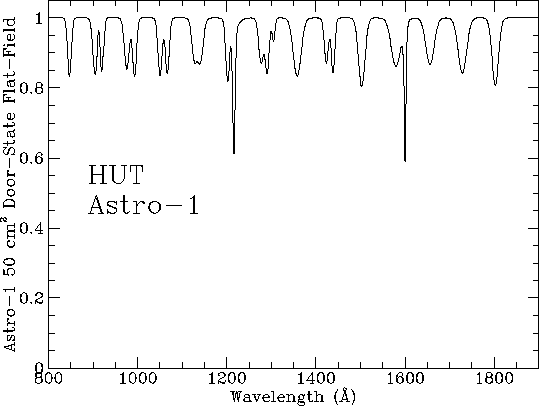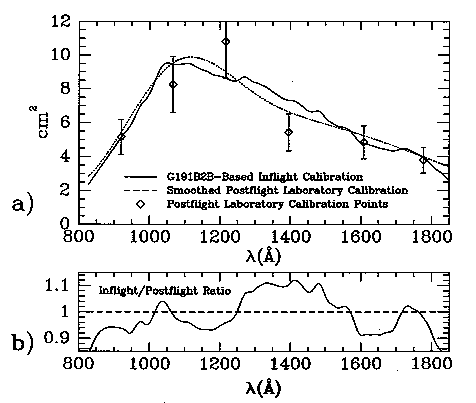 |
 |
![\begin{figure}
\framebox [6.5truein][l]{{\vbox to 11truecm{}}}
\end{figure}](hh_fig4-3.gif) |
Small-scale, pixel-to-pixel variations in the sensitivity of the HUT detector have three principal sources. First, a negatively charged grid is placed in front of the photocathode to enhance the capture efficiency of ejected photo-electrons. This grid has a transmission of 95%, and it is far enough from the focal plane that the pattern is highly defocussed in the f / 2 beam of HUT. When bright targets are observed through the small aperture doors, however, the much slower effective focal ratios cause the grid to cast distinct shadows on the detector. For Astro-1 these shadow patterns were measured in the Synchrotron Ultraviolet Radiation Facility (SURF) at the National Institute of Standards and Technology (NIST) in Gaithersburg, MD. The resulting flat field correction for the 50 cm2 small aperture door is shown in Figure 4-2. For Astro-2 the repelling grid in front of the photocathode has been modified so that no wires cross the region illuminated by the focussed spectrum. Thus these shadow patterns should be eliminated.
 |
The second source of small-scale sensitivity variations is defects or non-uniformities in the photocathode or the microchannel plate. Only one such spot was identified on the HUT detector for Astro-1, located at 1600 Å, and it is only noticeable in spectra obtained in half-aperture or small aperture door observations. This feature can be seen in the spectrum of G191-B2B as noted on Figure 4-3, and it is also apparent in Figure 4-2.
The third source of sensitivity variations is in the pair of amplifiers used
in reading the Reticon diode array. One amplifier serves the odd numbered
diodes, and another the even ones. These are balanced so that the resulting
signals differ by less than 1%. The residual imbalance produces an odd/even
pattern that is noticeable at the ![]() 0.5% level in the highest S/N spectra.
The odd/even pattern does not appear to be stable, and so no correction is
currently applied to the HUT data in routine processing.
0.5% level in the highest S/N spectra.
The odd/even pattern does not appear to be stable, and so no correction is
currently applied to the HUT data in routine processing.